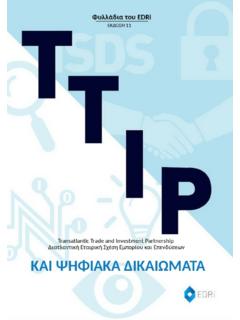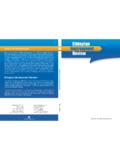Transcription of Income Elasticities of Demand for major consumption items.
1 International Journal of Scientific and Research Publications, Volume 2, Issue 6, June 2012 1. ISSN 2250-3153. Income Elasticities of Demand for major consumption items. Case study of Kashmir University Teachers Samira Khan Department of Economics, University of Kashmir, India Abstract- Kashmir University teachers belong to upper The idea that consumers are the supreme arbiters of what is sedentary and rich class is not a fact as the consumption behavior produced under a system of free enterprises has a long and shown by them is similar to middle class society. The sample central place in the history of economic thought. It has to be under examination differ in size of the family, age, designation, sharply distinguished from the teleological version, that the property ownership and other characteristics; in general we consumer should be sovereign, which has an even older origin in expect the household with above given different characteristics to Adam Smith without whose dictum consumption is the true end have different expenditure plans but the analysis shows same and purpose of all production no book on the political economy expenditure by every Income bracket which confirms of consumers would be complete.
2 Duessenbary s relative Income hypothesis. While analyzing the The traditional relationship between the amount of family Income pattern of Kashmir university teachers we find that all Income and the pattern of family expenditure was discovered in observations do not lie on the straight line because in addition to 1857 by the German Civil Servant Ernst Engel, in the the Income other variables also affect consumption pattern. examination of an extensive collection of family budgets .It is Direct taxes have more immediate effect on consumption and known as Engel s Law. In present context Engel s great Kashmir university teachers being healthy payer of taxes thereby contribution is the clarification and elaboration of the concept of their consumption pattern also shows a different behavior. the Income elasticity of Demand , which a frame work within which numerical measurement of consumer behavior could be Index Terms- consumption , disposable Income , affected.
3 Prior to 1936 economists would believe that interest Duessenbary s relative Income hypothesis, Income elasticity of determines the level of consumption . Demand , consumer durables According to Keynes consumption spending and saving are explained by the level of Income ; the relationships between I. INTRODUCTION spending, saving and the level of Income are shown by the consumption function and the saving function. In the elementary N o body denies the importance of consumers in the economy or ignores the momentous results that may flow from their decisions. Keynesian model, the rise in real Income of households will lead households to increase the amount of goods purchased and vice- The most appealing feature of economic research into versa. To consider how consumption expenditures are related to consumer behavior is the close relationship between theoretical disposable Income we may begin by posting that consumption specification and appropriate estimation technique.
4 There are two expenditures, vary directly with disposable Income . Second we major approaches to the estimation of Income elasticity, as they can quantify saying how much consumption increases with a are usually derived from budget surveys, used by national and specific increase in disposable Income . Keynes did this in his international agencies for the purpose of commodity projection. fundamental psychological Law which states that men are This is most apparent when empirical analysis and testing takes disposed, as a rule and on the average, to increase their place at micro level. consumption as their Income increases but not as much as the Attempts to discover consumer habits and preferences now increase in their Income . Four general theories currently exist on depend not only on intuitive theories but also on objective the determinants of total consumer spending: the absolute Income research.
5 Psychologists and economists make survey, often by a hypothesis, the relative Income hypothesis; the permanent sampling process, to learn how, when, and if possible, why Income hypothesis and life cycle Income hypothesis. Each consumer at various incomes levels and in various places spend hypothesis postulates a relationship between consumption and their money. Economists accumulate and interpret statistical Income though the concepts underlying these terms may vary information about consumer s habits in the past and their substantially. intentions to buy or not to buy various classifications of goods in future. Most certainly, any theory of consumer behavior must recognize the importance of social forces to shape consumer behavior. International Journal of Scientific and Research Publications, Volume 2, Issue 6, June 2012 2. ISSN 2250-3153. II. OBJECTIVES: 4. estimating the Engel Elasticities and behavioral parameters The present investigation has been carried out to study the of econometric model Income Elasticities of academia.
6 The investigation is taken with 5. Testing hypothesis. the following objectives:- 1. To know the consumption preferences of academia. The present study uses linear regression economic model. 2. To study whether the consumption preferences of university X= a+bY +U. teachers are different from accepted consumption hypothesis. Where X is consumption , Y is Income , a is autonomous 3. To study the asset preference in university teachers. consumption / intercept and b is the slope coefficient or marginal propensity to consume. U is known as the disturbance or error term in a random variable (stochastic variable) that has well III. LITERATURE REVIEW defined probabilistic properties. The term U may well represent all those factors that affect consumption but are not taken into Realizing the importance of consumer in the economic aspect account explicitly. many scholars and researchers from various disciples ranging To estimate the Income Elasticities and the behavioral from commerce, management etc intervene in the study of parameters of the econometric model the primary data required is consumer behavior.
7 Among a few studies directly or indirectly collected by questionnaires. dealing with the similar prospective have been under taken by The data for the study is outcome of a series of Stone Geary; Cable and Godge 1994; 1952; Lewis questionnaires collected from a random sample of the Kashmir Scheppar; ; Paris Quirino 1970;Muelbaures and University Teachers. The series consisted of the 110 waves of Deapon 1980; Richard Blundell 1954 have done comprehensive questionnaires taken from Kashmir University teachers. The data work in this field. In a study The impact of food price on under investigation is fragmented into 5 Income brackets The consumption ,feb2010 a systematic review of research on price size of the first bracket is 7. Teachers falling under second elasticity of Demand for food, by Tatiana Andreyeva ,Michael bracket is equal to 26, in the third bracket we have 29 teachers and Kelly lights the proposals to improve while in the 4th there are 18 teachers, in the last group is the diets by shifting food prices ,results potray percentage wise highest Income bracket the number of respondents is 9.
8 Increase in price and its impact on consumption . Ethiopian development research institute (EDRI) in a research note 90,FOOD Demand Elasticities IN ETHIOPIA 2011, V. RESEARCH FINDINGS AND INTERPRETATION. By Kibrom Tafere,Alemayehu seyoum Taffesse,S. Tamiru,Nigussie Tafera and Zelekawork Paulos ;investigates To analyze the consumption expenditure of Kashmir howhouseholds have adjusted their Demand for various food and University Teachers in general we first estimate the Income non food items to change in price and Income . The results Elasticities of various items separately food, non-food suggest that ETHIOPIAN households display significant consumer durables etc. This could be done in;. responses to change in price and Income . In both rural and urban a) The consumption Income relationship has to be areas consumption increases of teff, animal products, and non analyzed with the help of Engel Functions food items exceeds the proportional Income increase.
9 The price b) An Income distribution has to be compared with elasticity of Demand for cereals are roughly same throughout the consumption distribution. country. The present study will be an improvement over the existing The important economic determinants usually considered are knowledge. This analysis is carried out with the objectives to Income , price, level of assets held. Prices are kept constant and capture behavioral parameters of University teachers a white only Income is allowed to vary among household. Our main collar group and measuring Income Elasticities of academia and objective is to compare the consumption Income behavior of shall study the consumption preferences. Teachers within Kashmir University. For this we derive Income I. It is believed that consumption preference in case of Elasticities by fitting various types of functional forms. high Income brackets are oriented to consumer durables With a view to assess, the impact of higher Income on than necessities.
10 Standard of living, we use suitable econometric and statistical II. University teachers though falling in high Income techniques brackets have not high disposable Income , however An attempt has been made in this regard their consumption preference need to be investigated, (I) To assess the differences in consumption pattern of whether they are oriented to durables or basic consumer University teachers. items. (II) To work out the distribution of consumption expenditure. The proposed analysis will proceed as, IV. RESEARCH METHODOLOGY first; the consumption pattern of Kashmir University Teachers will be examined. This will be followed by the Methodology of the present study proceeds along the analysis of the composition of the consumption following lines expenditure taking into account, the consumer durable 1. Statement of the problem etc. as part of consumption . Side by side we analyze the 2.













